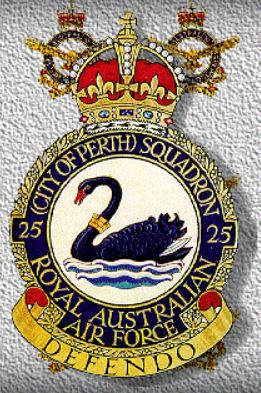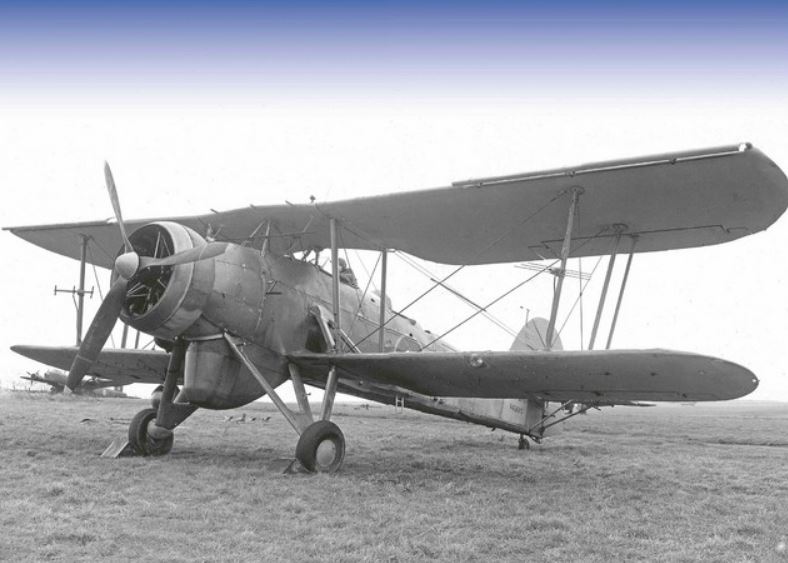Difference between revisions of "No. 25 (City of Perth) Squadron RAAF"
From Our Contribution
(→Ground Crew) |
(→Ground Crew) |
||
| Line 37: | Line 37: | ||
* [[Edward Arthur Ross]] 24 Jul - 22 Oct 1941 | * [[Edward Arthur Ross]] 24 Jul - 22 Oct 1941 | ||
* [[John Thomas Thomson]] 28 Apr - 10 Nov 1942 | * [[John Thomas Thomson]] 28 Apr - 10 Nov 1942 | ||
| + | * [[Angus Lenard Hurley]] 8 Oct 1942 - 29 Sep 1944 | ||
* [[William Kenneth Watson]] 7 Mar 1943 - 20 Jan 1945 | * [[William Kenneth Watson]] 7 Mar 1943 - 20 Jan 1945 | ||
* [[Oswald Francis Williams]] 26 Jul 1943 - 6 Sep 1943 | * [[Oswald Francis Williams]] 26 Jul 1943 - 6 Sep 1943 | ||
Revision as of 20:28, 4 April 2024
 No. 25 Squadron badge / colour patch | |
 One of the three Swordfish used on anti-submarine patrols around Rottnest Island until 1942 | |
Contents
Brief History
Originally formed as No. 23 (City of Perth) Squadron in early 1943 at RAAF Base Laverton before being renumbered No.25 and moved to RAAF Base Pearce in January 1939. With the outbreak of war it was allocated some CAC Wirraways to carry out Convoy escort duties and anti-submarine patrols. With Japan's entry into the war the squadron received a small number of Brewster Buffalo aircraft, and in early 1942 three Fairey Battle biplanes. The later were used to conduct patrols around Rottnest Island until late 1942 before they were returned to the Royal Navy.
In Aug 1943 the squadron was re-equipped with Vultee Vengeance dive bombers to defend against a rumored Japanese invasion, and began joint exercises with the Army. With the removal of the threat to Perth, the squadron was again re-equipped, this time with Consolidated B-24 Liberators, and began to carry out bombing raids against Japanese targets in what is now the Indonesian islands. These sorties required refueling stops at Truscott or Corunna Downs airfields. In June 1945 the squadron relocated to Tarakan in order to play a bombing role assisting the landings at Brunei Bay. With the completion of the war, the squadron moved to Cunderdin and was involved with the evacuation of liberated POWs from Borneo and Morotai to Australia before being disbanded in July 1946. Twenty five of its personnel were killed during the war.
It reformed in 1948 as a Citizen Air Force Unit and went through various guises before July 1998 when its permanent personnel separated to form the No. 79 Squadron. Those that remained returned to the role of providing a reserve pool of personnel.
Battle Honours
- Eastern Waters 1942 - 1945
Individual Honours
- 1 x Mentioned in Despatches
Air Crew
- Tom Shelley Griffiths 20 Jan - 17 May 1943
- Edward Harry Tasker 24 Feb 1944 - 28 Jan 1945
Ground Crew
- † Herman Fred Sass 5 Jul 1937 - 12 Feb 1939
- Warwick Geoff Samuel Savage 6 Jun - 21 Aug 1941 & 25 Sep 1943 - 22 Jan 1945 & 4 Jan - 15 Apr 1946
- Edward Arthur Ross 24 Jul - 22 Oct 1941
- John Thomas Thomson 28 Apr - 10 Nov 1942
- Angus Lenard Hurley 8 Oct 1942 - 29 Sep 1944
- William Kenneth Watson 7 Mar 1943 - 20 Jan 1945
- Oswald Francis Williams 26 Jul 1943 - 6 Sep 1943
- Ivan Lindsay Dunn 11 Apr - 7 Sep 1944
- William John Gardener 11 Apr - 28 Sep 1944
- Harold Morgan 2 Jul - 16 Dec 1944
- Ronald Victor Marshall 20 Jan 1945 - 22 Nov 1945
- Frederick Walter Miller 23 Jan - 5 Sep 1945
- Alwyn Raymond Liddell 31 Jan - 4 Jul 1945
- Eric William Mills 21 Nov - 11 Dec 1945
- Alfred Ensor Hand 4 Jan - 15 May 1946
- Frederick George Thornton 5 Mar - 19 May 1946
Notes